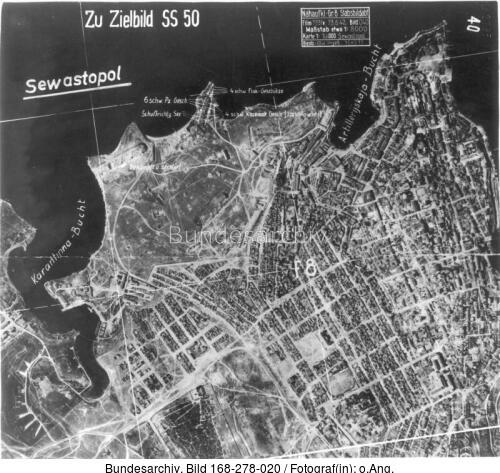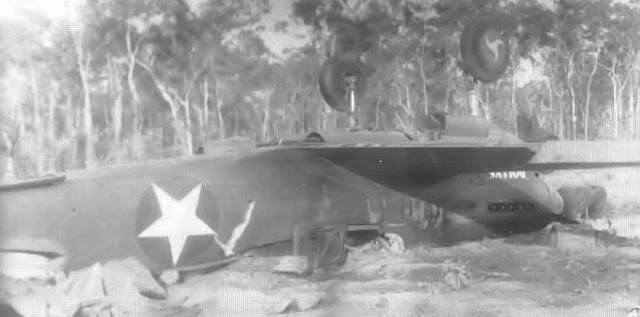Saturday 13 June 1942
 |
| The Bf-109F4Trop of Luftwaffe ace Hans Joachim Marseilles (WNr 10137) of 3.JG27 near Bir Hackeim in North Africa, 13 June 1942. Note planes taking off in the background (Optiz, Richard, Federal Archive Picture 101I-443-1567-19). |
Eastern Front: The Germans continue grinding forward toward the port of Sevastopol on 13 June 1942. In the northeast sector, the German 22nd Infantry Division attacks at 03:00 with the goal of taking the important Soviet fortress Fort Stalin. The Soviets have just 200 men to hold it. After brutal hand-to-hand fighting, the Germans take the critical fort, which controls the way to Severnaya Bay.
The Soviets counterattack, but the Germans, now in possession of the fort, hold it and wipe out a company of Soviet soldiers. The Germans lose 32 dead, two missing, and 126 wounded and now have a clear path into the port of Sevastopol. At Fuhrer Headquarters in East Prussia, General Halder notes with satisfaction that "According to reports from frontline commands, the enemy is beginning to soften." This is a good thing for 11th Army Commander General Erich von Manstein (undoubtedly the source of this "news") because Hitler has been threatening to withdraw attack forces and convert the battle into a siege due to its slow progress. This would rob Manstein and the 11th Army of the glory of a quick, victorious campaign, so he needs results soon.
Local Luftwaffe commander Wolfram Von Richtofen, though, is more concerned about turf wars. His flak guns (primarily 88mm) are also useful against ground targets, so the army keeps "borrowing" them without asking his permission. This has been a constant source of friction throughout the campaign that has reached the highest levels of local leadership. He vents his frustration in his diary today:
I keep all flak guns subordinate and deploy them together in great concentration at Schwepunkte [the point of attack] against ground targets. The army wants formally to control them and spread them throughout divisions and, therefore - as always, like last time at Kerch - fritter them away. The most basic reason: the competitive jealousy of the army's artillery [soldiers], to whom I cannot give my flak guns because they have obsolete ideas and want to deploy them according to the tactical viewpoints of Wallenstein [from the 17th Century]. I remain stubborn, and the army continues to rage.
While this sort of thing may seem minor, it is a vivid illustration of the inter-service rivalries and jealousies that characterize the Wehrmacht (and other armies to one extent or another).
In general, the Luftwaffe is having a great time over Crimea. The front is so confined that Richtofen can actually see the remaining Soviet airfields from his observation tower. He personally can see when they are preparing to take off (dust clouds erupt when the engines start) and alerts his own fighter units, which can shoot them down as they take off. "Destroyed 18 Russian [aircraft] in this manner today," he writes today in his diary, "four by bombing. It is great fun!"
Farther north on the front, the Germans have been trying to corner a large partisan force led by Soviet General Mayor Belov in the vicinity of Bryansk. Operating in a heavily wood area, Belov has a heterogeneous force composed of partisans, airborne troops, regular army soldiers, trucks, wagons, and tanks. The weak link in the German effort is a thinly held road on the east (the Rollbahn) which Belov's forces have been able to cross basically at will because the Germans do not have enough troops to close it. The Germans finally succeed in building a screening line along the entire road about this date and await a breakout attempt.
The main concern among German leadership, though, is not these minor operations, but the looming main offensive on the southern front. General Halder notes with satisfaction success in one of the preliminary operations for Operation Blau. Operation Wilhelm is a shallow pincer operation launched by the Sixth Army on June 10th east of Kharkov by VIII Corps in the north near Volchansk and III Panzer Corps in the south near Chuguyev. The aim was to cross the Donetsk River and meet near Belyy Koloez. Today the pincers meet after III Panzer Corps fights through several lines of Soviet tanks. Halder notes with satisfaction, "Operation Volchansk has scored a fine success. Large enemy bodies encircled, 20,000 PWs [prisoners] so far." The total POW count after all the counting is done comes to 24,800. Another preliminary attack, Operation Fridericus II, is planned to begin in about a week.
Not everything is rosy in Rastenburg, however. Halder records a meeting with General Quartermaster (supply chief) Eduard Wagner regarding Blau. "Fuel problems. Computations indicate that the fuel reserve for 'Blau' will last only until mid-September." He also has a meeting with General Blumentritt about "Preparations for next winter," though nobody has any idea where the front will be then.
A more ominous entry is a meeting that Halder has with General Ochsner about the Crimean campaign. "Approach to chemical warfare of the part of the enemy powers (increasing interest)," Halder writes, and the conversation then turns to "Conditions for gas warfare on the Volkhov river." The implication here is that Allied preparations for chemical warfare (some is being manufactured in Canada, for instance) may be used by the Germans as a pretext for actually using gas on the battlefield.
 |
| Luftwaffe aerial reconnaissance of Sevastopol (Karantinna Bay, Artilleryskaya Bay, scale 1:8000), 13 June 1942 (Federal Archive Picture 168-278-020). |
Battle of the Pacific: The victorious U.S. Navy carriers of Task Force 11 from the Battle of Midway return to Pearl Harbor, now commanded by Admiral Frank Fletcher aboard USS Saratoga. Fletcher's command is short-lived, however, as he disembarks today and is soon replaced. The Japanese fleet - what remains of it - is still a day away from a safe anchorage at Hashirajima.
The Japanese send 27 "Betty" bombers against the RAAF airfield at Port Darwin. Led by Lieutenant Commander Goro Katsumi of the Takao Ku, the bombers leave Koepang at 08:12, escorted by 45 "Zeke" fighters of the 3rd Ku. They are intercepted by 36 P-40 Warhawks of the 49th Fighter Group. The Americans lose three planes in the encounter, while the Japanese lose two Zekes. There are multiple accusations by American pilots that the Japanese strafed U.S. pilots in parachutes, though everyone survived. The bombers do get through and drop 19,980 kgs of bombs on the airfield, damaging the runways, water pipeline, fuel dum, and telephone poles. One Lockheed Hudson is damaged on the ground.
In Alaska, the USAAF 11th Air Force continues to harass the new Japanese presence on Kiska Island. Despite bad weather, it sends five B-17s three B-24 Liberators, and PBY Catalinas to bomb shipping there.
US submarine USS Sargo torpedoes and sinks Japanese troopship Konan Maru off Yap, Caroline Islands.
US Submarine Drum (SS-228) torpedoes and sinks Japanese freighter Shonan Maru northeast of Mikimoto, Honshu.
Japanese freighter Nagasaki Maru hits a Japanese mine and sinks off Nagasaki, Japan.
RAAF Hudsons attack Japanese shipping off Ambon, NEI (Indonesia), sinking auxiliary patrol boat Taifoku Maru and damaging gunboat Taiko Maru.
The USAAF 5th Air Force once again sends B-17 bombers to attack Lakunai Airfield at Rabaul.
Battle of the Indian Ocean: An unidentified Japanese submarine torpedoes and sinks 3748-ton Yugoslavian freighter Supetar in the Mozambique Channel about 100 nautical miles (190 km) south of Beira, Mozambique.
 |
| A downed P-40 after the 13 June 1942 Japanese raid on Port Darwin (Credit: "49th Fighter Group: Aces of the Pacific" by William N Hess). |
European Air Operations: The weather continues to be poor on the Channel Front ("10/10ths" in pilot-speak). Many RAF units occupy themselves throughout the day with practice bombing, gas drills, aerobatics and formation flying, and similar exercises. There are some convoy patrols that do not find any enemy ships.
Luftwaffe planes find 345-ton Dutch freighter Brabant off the coast of north Cornwall and sink it. there are no known casualties.
Battle of the Baltic: Soviet submarine Shch-405 has hit a mine and sinks in the Gulf of Finland off Someri Island, and today the Soviet Navy writes it off. The wreck is found in 2018. The Finns have an observation post on the island and the Soviets are considering sending a force to occupy it.
Battle of the Atlantic: US Coast Guard cutter USS Thetis drops depth charges on U-157 (KrvKpt. Wolf Henne), on its second patrol out of Lorient, northeast of Havana, Cuba, sinking it with all hands. All 52 aboard perish. U-157 ends its career with one victory of 6401 tons.
Italian submarine Leonardo Da Vinci torpedoes and uses its deck gun to sink 6438-ton British freighter Clan Macquarrie in the general vicinity of Freetown. There is one death, the Chief Engineer.
Before dawn, U-159 (Kptlt. Helmut Friedrich Witte), on its second patrol out of Lorient, pumps two torpedoes into 4693-ton US passenger ship / freighter Sixaola 50 miles off Bocas Del Toro, Panama. There are 29 deaths and 172 survivors. Most of the survivors are picked up by American gunboat USS Niagara (PG-52) and US Army tug Shasta, while 42 make landfall in a lifeboat.
U-159 gets another victim at sunset when it sends another two torpedoes into 6762-ton American freighter Solon Turman 100 miles north of Cristobal, Canal Zone. There are one death and 52 survivors. In both of these sinkings, the U-boat surfaces and offers assistance to the survivors before departing.
U.S. tanker Gulfprince has a close call six miles south of the Ship Shoals Sea Buoy off the coast of Louisiana when U-506 attacks it. The tanker evades two torpedoes, then evades a third. A fourth hits it but does not explode. Gulfprince scoots into New Orleans.
The Vichy French agree to immobilize aircraft carrier Béarn, light cruiser Emile Bertin, and training cruiser Jeanne D'Arc at Martinique, French West Indies.
 |
| An Allied convoy forms up to cross the Atlantic Ocean, 13 June 1942. (Naval Supply Corps Newsletter/Library of Congress). |
Battle of the Mediterranean: German General Erwin Rommel's forces break out of the "Cauldon," routing British and South African forces trying to hold the Gazala Line. This becomes known as "Black Saturday" in the British Army.
The breakout begins when the 21st Panzer Division uses the cover of a sandstorm to attack the 2nd Scots Guards and 6th South African Anti-tank battery (eight guns) at Rigel Ridge, a key defensive position on the "Knightsbridge Box." The Guards Brigade is forced to withdraw after dark. Ultimately, the South African artillery unit is overrun, with the gunners firing at the approaching panzers over open sights. The Germans capture over 3000 prisoners and destroy 138 Allied tanks.
British 8th Army now has only 75 armored vehicles remaining. This disaster compels British commander General Auchinleck to order a general retreat from the Gazala Line. This once again exposes Tobruk to attack. Auchinleck also is quickly falling out of favor with Prime Minister Winston Churchill.
At sea, Axis forces continue their attacks on two Royal Navy convoys converging on Malta from opposite ends of the Mediterranean. The convoy heading from Gibraltar is Operation Harpoon, while that from Palestine and Egypt is Operation Julius.
The three separate convoys of Operation Julius assemble off of Mersa Matruh, Egypt, during the afternoon as the weather deteriorates. As a side effort, a submarine accompanying the convoy lands five commandos on Crete, and they destroy about 20 Luftwaffe aircraft at Maleme Airfield. This does not stop Axis air attacks, however, which begin after dark and last through the night, with the convoys illuminated by flares.
U-83 (Kptlt. Hans-Werner Kraus), on its eighth patrol out of Salamis, while patrolling off Al-Ramkin Island, Lebanon, uses its deck gun to sink 91-ton British schooner HMS Farouk. There are nine deaths and nine survivors.
 |
| Scene from one of the convoys to Malta on or about 13 June 1942 (© IWM A 10853). |
Battle of the Black Sea: The Luftwaffe, which is once again permitted to operate over the Black Sea due to a secret deal between the local Luftwaffe commander and the head of local naval forces (and contrary to a standing order of overall Luftwaffe commander Wolfram von Richthofen), bombs and sinks Soviet transports Gruzyia and TSch-27, patrol boat SKA-092 and minesweeper T-413 off Cape Fiolent, motor ship SP-40, five barges, and a floating crane, most in Sevastopol Harbor.
The Soviets get one back with a pre-dawn attack on the German naval base at Yalta. Bombers hit the port while a Soviet MTB slips in and fires three torpedoes at the crowded port. It sinks the Italian mini-submarine CB-5 and causes damage to other vessels. This attack alarms local naval commander Konteradmiral Schweinitz and causes the Germans to send additional flak batteries to the port and for the Kriegsmarine to install anti-torpedo nets.
Spy Stuff: The four German saboteurs landed by U-2020 on Amagansett Beach (Operation Pastorius) on 12 June arrive in New York City and book hotel rooms in Manhattan. Up to now, they have strictly followed protocol and assumed that everyone else in their unit is devoted to the Third Reich. However, during the evening two of the men have a heart-to-heart and confess to each other that they oppose the regime and the mission.
Meanwhile, the Coast Guardsman who spotted the Germans during his normal foot patrol as they arrived, Seaman 2nd Class John C. Cullen, alerts his superiors. A search of the beach reveals their buried uniforms and equipment. The Coast Guard alerts the FBI and the White House. This begins a manhunt, but the authorities have no idea where to look. The incident is kept secret so as to not alarm the public.
 |
| The OSS, the predecessor of the CIA, is created on 13 June 1942. |
Applied Science: The US Navy uses non-rigid airship K-2 to test the Long Range Navigation (LORAN) system from the airship base at Lakehurst, New Jersey. This first airborne test is a success, as the equipment guides the airship from 50-75 miles offshore to, as the pilot says, "the middle of the hangar."
US Military: The first issue of Yank magazine is published, dated 17 June 1942. The final issue is 28 December 1945.
The US 1st Armored Division in Northern Ireland receives the last of its tanks. The Americans hold a parade through town, and Sir Archibald Sinclair gives a speech. The US presence in Ireland is intended not just to build up an American military presence in the British Isles, but also to play on Irish sympathies for America. Americans, for instance, financed much of the Irish fight for independence and there are many Irish-Americans in the U.S. armed forces.
The Bureau of Navigation is renamed the Bureau of Naval Personnel.
German Military: Munitions Minister Albert Speer, General Adolf Galland, and General Erhard Milch visit Peenemunde to observe a test flight of the Me 163A. Three aircraft take off at once in a formation takeoff. The Me 163 Komet is a revolutionary rocket plane already has set a new world speed record (on 2 October 1941). While very fast, the plane still has some issues, such as a jettisonable undercarriage that makes landing an adventure.
US Government: President Roosevelt issues Executive Order 9182, creating the Office of Strategic Services (OSS) and Office of War Information (OWI). The former, which coordinates overseas espionage activities, is ultimately succeeded by the Central Intelligence Agency (CIA). The latter is a major propaganda initiative that results in the Voice of America (VOA), numerous patriotic radio programs that glorify the new U.S. ally Russia (such as "An American in Russia,"), and pro-war effort films and documentaries (such as "This is Our Enemy").
 |
| Advertisement in The New Yorker, June 13, 1942 p. 9. |
American Homefront: In her syndicated "My Day" column, First Lady Eleanor Roosevelt writes:
In the morning paper I read that, not satisfied with wiping out the village of Lidice, the Germans have gone further and killed 34 more people in the cities of Prague and Bruenn ‘in reprisal.’ It does not seem to cross their minds that they are imprinting the name of this village on the minds of the people of the world. None of us will ever forget a little village named Lidice. Reprisals of this kind only bring more reprisals, so that it is an unending spiral of murder.
Roosevelt is correct that the name of Lidice will be long-remembered. The Germans have placed a bounty on the assassins of Reinhard Heydrich and given local communities until 18 June to turn them in.
 |
| The Saturday Evening Post of 13 June 1942. |
2022

No comments:
Post a Comment